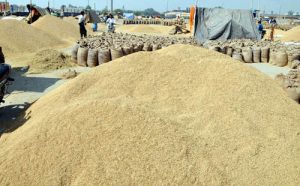 Prof. Raj Kishore Panda in Bhubaneswar, July 10, 2022: Chief Minister of Odisha, Naveen Patnaik in his recent address at the World Food Programme headquarters in Rome has declared Odisha as a food-surplus state. This assertive statement of the Chief-Minister for a state conventionally recognized as agriculturally backward and poverty stricken certainly carries significance.
Prof. Raj Kishore Panda in Bhubaneswar, July 10, 2022: Chief Minister of Odisha, Naveen Patnaik in his recent address at the World Food Programme headquarters in Rome has declared Odisha as a food-surplus state. This assertive statement of the Chief-Minister for a state conventionally recognized as agriculturally backward and poverty stricken certainly carries significance.
More so, since food surplus alternatively means over production of food grains, for a poor state like Odisha growing too much food grains beyond the need has its economic and ecological implications.
No doubt during the last two decades, there has been some significant improvements in the performance of the state’s agriculture sector in terms of changes in the cropping pattern, crop productivity, diversification towards commercial crops etc, leading to higher growth in agricultural GSDP (nearly 4 % between 2001-02 and 2017-18), Yet, the Chief Minister’s claim that the state has moved away from a food-deficit to a food-surplus state during this period (2000-2022) seems to be assessing too high the development of the state’s agriculture sector.
In the common parlance food surplus is defined as a state in which supply of food grains exceeds the demand for it. In the present context of too much climatic and economic uncertainty, a surplus in one or two years can be offset by the deficit in other years.
As such while talking of food surplus in a state there is need for looking at availability of food grains from a long run perspective over the requirement of its population including nutritional requirements. On the backdrop we have here thrown some light on the trends in the growth of food grains production and to what extent the available food supply is greater than the need of the people in the state.
Looking at the latest available data on food grains production in the state over the last six years – from 2014-15 to 2019-20, we find a severe year to year fluctuation in the quantum of food grains produced. While during 2014-15 the state recorded 118.24 million tonnes of food grains production it declined sharply to 76.30 million tonnes in 2015-16 after which it made a moderate revival to 116.82 million tonnes in 2016-17.
 In subsequent year that is in 2017-18 there has been again a steep fall in production to 84.83 million tones which again met with a marginal revival to 96.72 million tonnes in 2018-19 and subsequently to 115.71 million tonnes in 2019-20. Compared to 2014-15 there has been a negative growth rate in food grains production by 2.14 per cent in 2019-20.
In subsequent year that is in 2017-18 there has been again a steep fall in production to 84.83 million tones which again met with a marginal revival to 96.72 million tonnes in 2018-19 and subsequently to 115.71 million tonnes in 2019-20. Compared to 2014-15 there has been a negative growth rate in food grains production by 2.14 per cent in 2019-20.
Leaving aside the macro-level scenario of food grains production which demonstrates a high degree of instability from year to year, we find wide disparity in the food grains availability across districts. Based on Food Availability Index (2015-16), the study conducted by the Institute of Human Development and IGIDR in 2018, reveals that of the total 30 districts in the state, while 11 districts may be categorized as food secure districts other 19 come under food insecurity category – the latter further grouped under three heads on the degree of food insecurity as (i) extremely insecure districts (2), (ii) severely insecure districts (6) and( iii) moderately insecure districts (11).
Leaving aside the supply of food grains, it is the demand for food grains that determines whether the state’s available food grains is accessed by the people. Food surplus comes only after the domestic demand is met. In this context, we have to look into the extent of demand for food grains in the state.
It is to be acknowledged that demand for food grains is determined by several factors and most significant among them is the purchasing power with the people to access food. As per the latest available data (2011-12), in Odisha 32.6 per cent of the population are below poverty line. Recently NITI Aayog reports (2021) that one in every three persons in the state is poor. Besides, agricultural labourers who constitute a large majority of workers in rural Odisha happen to be extremely poor. All these people lack purchasing power to buy required food grains from the market.
Based on the NSSO 68th Round data (2011-12) we find that the average rural monthly per capita consumption expenditure in Odisha is the lowest in the country (Rs 1003/-). At the all-India level the same comes to Rs 1430/-. The NSSO estimate of per capita consumption expenditure acts as a proxy for per capita income. As such this reflects a significant dimension of access to food by the people in the state.
 Compared to national average the intake of calories (kcal) and proteins among the people in the state is very low. In 2011-12 the per capita per day intake of calories and proteins in Odisha comes to 2215 kcal and 53.4 grams as compared to the all-India average of 2233kcal and 60.7 grams respectively. All these reveal large scale undernourishment prevailing in the state.
Compared to national average the intake of calories (kcal) and proteins among the people in the state is very low. In 2011-12 the per capita per day intake of calories and proteins in Odisha comes to 2215 kcal and 53.4 grams as compared to the all-India average of 2233kcal and 60.7 grams respectively. All these reveal large scale undernourishment prevailing in the state.
From the above facts, it may be inferred that taking into account the large scale under-consumption due to poverty and low purchasing power and under-nutrition prevailing, the food grains production in the state looks inadequate to meet the need of the people.
More so, the food supply data while providing information on the amount of available food in the state for consumption does not take into account real food intake that is mostly obtained from individual diet surveys. Odisha should take up such type of surveys for better assessing food demand for the state and accordingly manage the resources for better performance of the state’s agriculture sector.
- Formerly, Professor of Economics, Utkal University & Director, NKC Centre for Development Studies ( ICSSR Institute) , Odisha, Bhubaneswar.


Leave a Reply
Be the First to Comment!